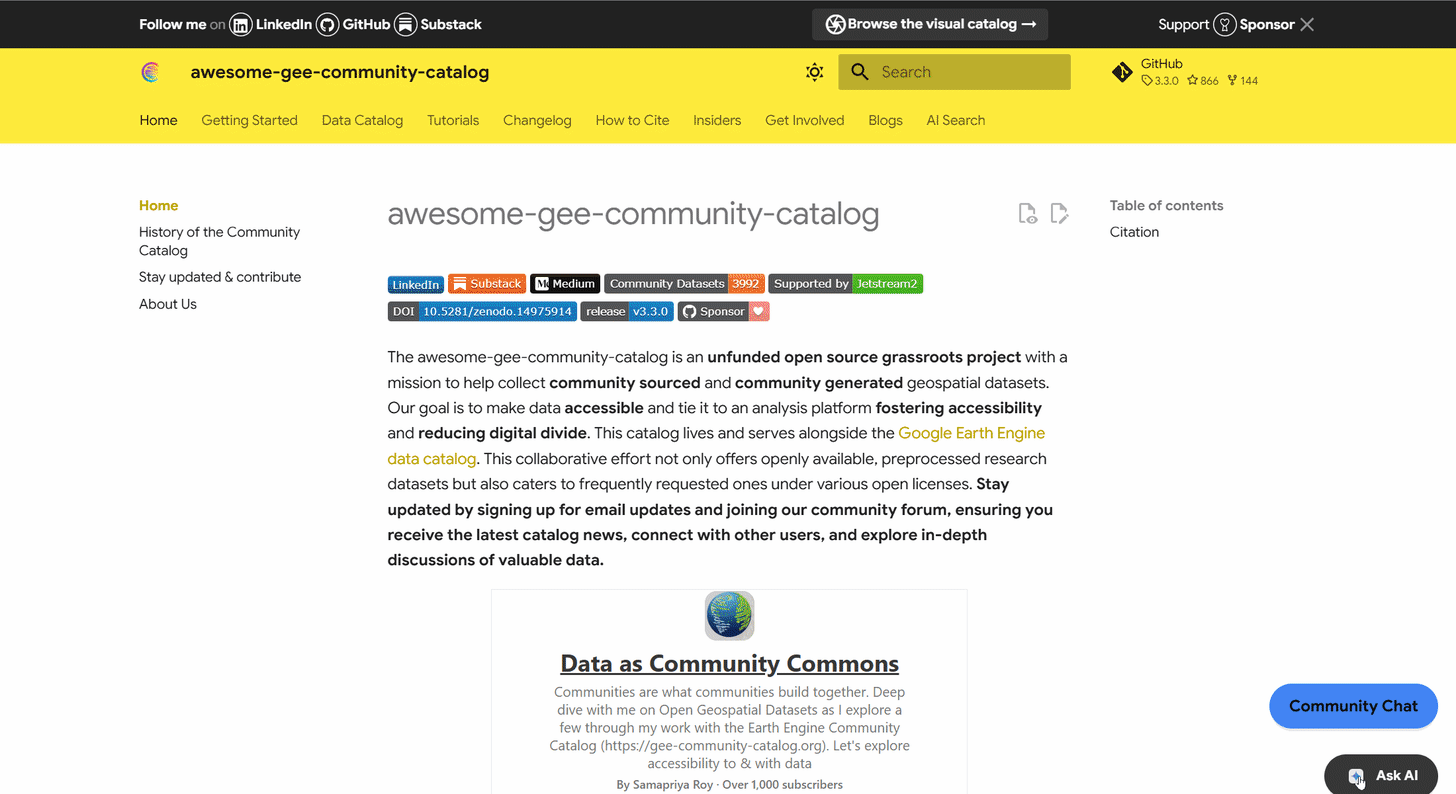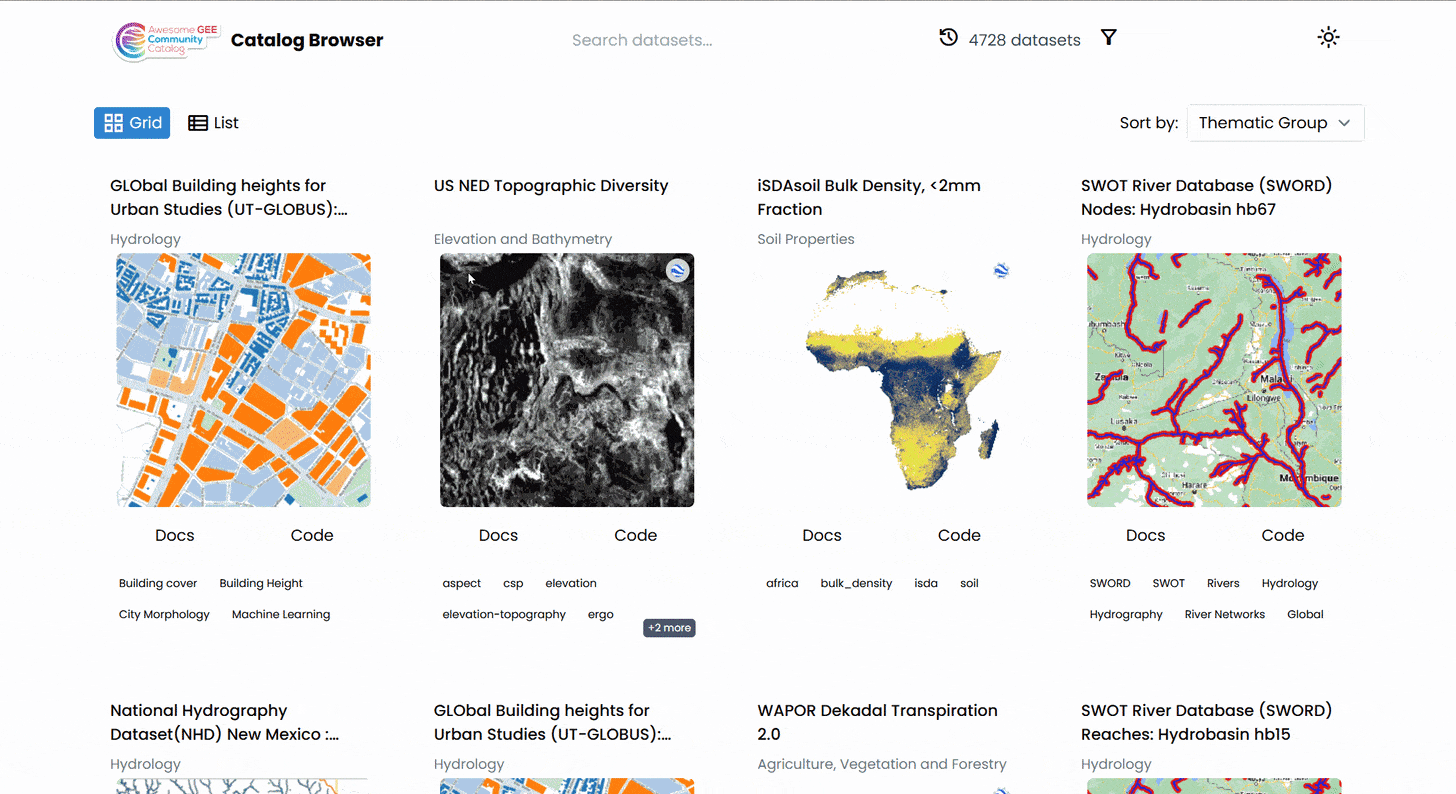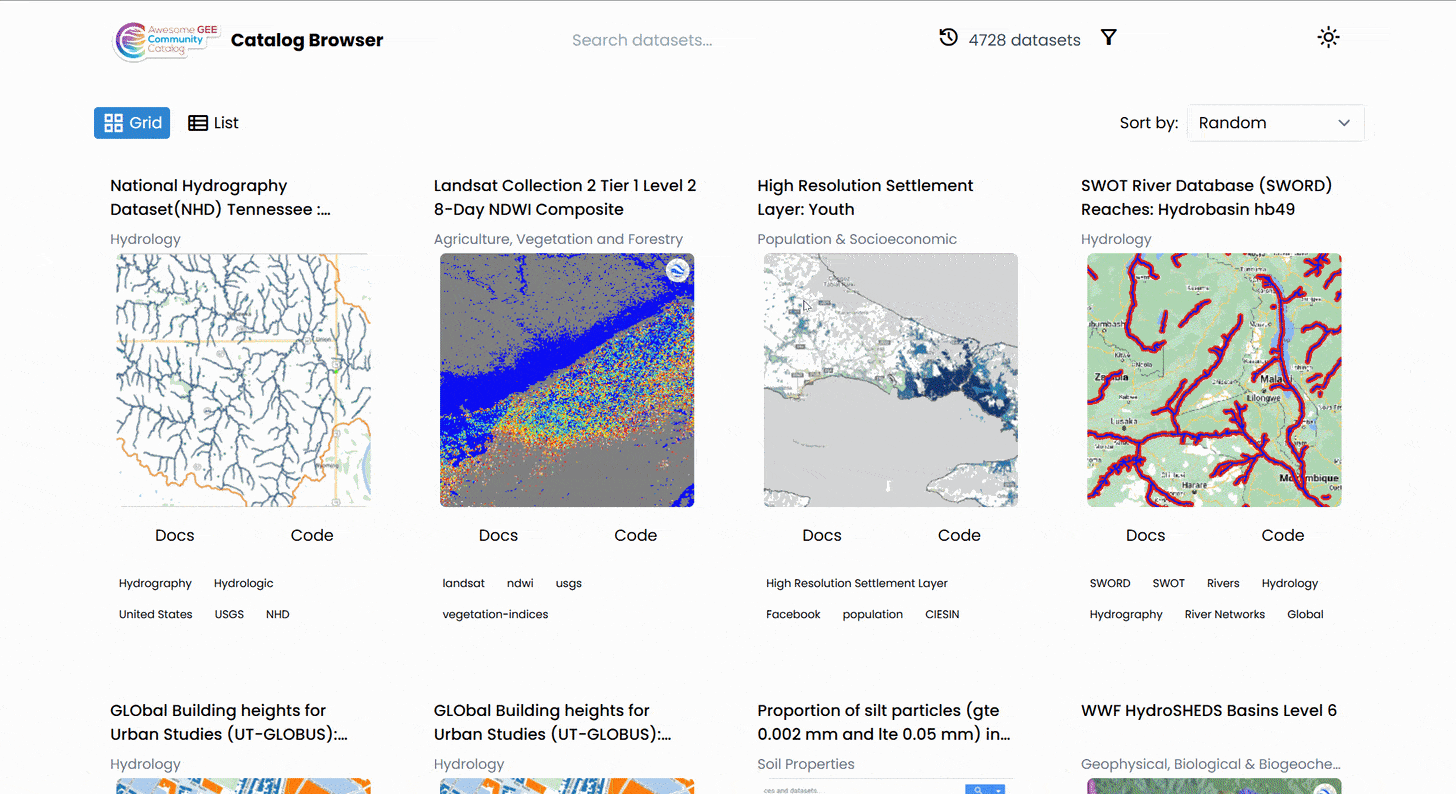Building the Community Catalog Browser: A Visual Field Guide
See the Community Catalog through new eyes with a visual browser that bridges quick discovery and deep analysis, creating intuitive pathways for every Earth Engine explorer.
🌍 🛰️The Google Earth Engine (GEE) Community Catalog has long served as the backbone for geospatial researchers and developers seeking to leverage Earth observation data. Today, I am excited to introduce a complementary tool that enhances this experience without reinventing it: the GEE Community Catalog Browser.
This browser doesn't replace the comprehensive catalog you've come to rely on instead, it offers a visual gateway, allowing users to quickly preview and interact with datasets before diving deeper into the catalog itself. It's a step forward in how we approach community-driven geospatial resources.
🔍The Data Discovery Dilemma
For those immersed in the world of Earth observation, the challenge of pinpointing the precise dataset needed for a specific analysis is a familiar one. Historically, this process has often felt like sifting through an immense digital haystack, with researchers dedicating substantial time to the hunt itself, sometimes overshadowing the crucial analysis that follows. The sheer volume of available data has amplified this challenge exponentially. The GEE Community Catalog alone now boasts nearly 4000 datasets, encompassing over half a petabyte of information. This explosion in data, while offering unprecedented opportunities, has also intensified the complexities of data discovery.
🤖 The introduction of an AI-powered natural language search in the community catalog last year aimed to alleviate some of this burden, allowing users to pose queries in plain language, for example
✅ "Show me flooding datasets in the catalog"
✅ "How can I study fire risk in urban areas?"
This ongoing effort leverages the wealth of information within the community catalog pages themselves. However, it became clear that another approach could offer a complementary advantage: a visually driven interface that allows users to quickly scan and filter datasets through thumbnail previews.
This concept arose from the needs of interdisciplinary researchers who frequently require the integration of datasets from both official and community sources, a need echoed in user feedback. The cumulative effect of the traditional, text-based search process has quietly consumed countless research hours, representing a significant, often unseen, drain on time that could be better spent on scientific inquiry. This new visual browser directly addresses this cognitive overhead.
🖥️ The Digital Companion: Understanding the Browser's Role
The GEE Community Catalog Browser was conceived as a digital companion to the already robust catalog system. It functions as a "quick-look" version, providing intuitive visual previews and a streamlined navigation experience that works in tandem with the full catalog. This approach reflects a strategy of incremental development, focusing on building flexible solutions that enhance existing frameworks rather than attempting a complete replacement. Such incremental improvements, like the earlier integration of thumbnails within JSON files, lay a strong foundation for significant user experience advancements over time.
The relationship between the browser and the catalog mirrors successful digital ecosystems observed across the technology landscape. Much like how a streamlined app can offer a focused experience alongside a more comprehensive website, the GEE Browser translates complex geospatial datasets into visually accessible previews. This translation isn't about oversimplification that sacrifices depth; instead, it's about creating multiple entry points tailored to a diverse community with varying levels of expertise and a wide range of specific use cases. This aligns with the trend of user-friendly interfaces becoming increasingly crucial for navigating vast amounts of information
🌍 Unified Access: Bridging the Divide Between Catalogs
A particularly noteworthy achievement of the new browser is its seamless integration of both the Community Catalog and the main Earth Engine catalog within a single, unified interface. Previously, these two valuable repositories existed somewhat independently, each requiring distinct search strategies and workflows. For users engaged in interdisciplinary research, where combining datasets from both sources is often essential, this separation introduced complexity.
The browser effectively eliminates this barrier by implementing a normalization of thematic categorization across both catalogs. Users can now filter datasets using consistent terminology regardless of their origin, whether they are exploring community-contributed lidar collections or official satellite-derived vegetation indices.
This unified access simplifies the discovery process significantly. This harmonization represents a substantial amount of behind-the-scenes work to align metadata structures and classification systems across the two catalogs, a technical accomplishment that ultimately translates into a more intuitive and efficient experience for all users.
Furthermore, each dataset within the browser includes
🔹 Direct links to comprehensive documentation 📜
🔹 Sample code for easy implementation 💻
This benefits both experts and beginners 👩💻👨🔬whether you need granular metadata or guidance for research workflows.
🛠️ Advanced Tools for Efficient Discovery: Beyond the visual
While the visual appeal of the browser is immediately apparent, it also incorporates advanced functionality designed to accommodate a wide spectrum of research workflows. Users have the flexibility to sort datasets thematically or alphabetically by title, supporting both exploratory browsing and targeted searches. The inclusion of filters allows users to refine their results based on keywords, tags, or predefined themes, enabling the creation of highly tailored views of extensive dataset collections. This level of customization empowers users to quickly narrow down their options and focus on the most relevant data for their specific needs.
Another valuable feature is the tracking of search history within each browsing session. This allows users to easily revisit previous searches without losing their context, a significant advantage for iterative exploration processes where comparisons between multiple datasets are common. Importantly, this search history is stored locally rather than in cloud databases, prioritizing user privacy while enhancing usability.
To ensure a smooth and coherent browsing experience, even when navigating through a large number of results, pagination has been implemented. This addresses a common frustration with extensive catalogs where inconsistent displays can disrupt workflow continuity.
Finally, one of my favorite features recognizing the diverse usage patterns of Earth Engine users, the browser also includes a dark mode option, providing a more comfortable viewing experience which I think is always a nice to have.
Incremental Growth: Building on a Foundation of Innovation
The development philosophy underpinning the GEE Community Catalog Browser is one of incremental enhancement rather than disruptive overhaul. By focusing on refining established workflows and building upon existing infrastructure, it respects the familiar practices of its user base while introducing significant and meaningful improvements. This measured approach minimizes disruption and ensures a continued use of those already accustomed to the Community Catalog.
This philosophy extends beyond the user interface into the underlying technical infrastructure. Earlier enhancements, such as the integration of thumbnail images within the JSON files that describe the datasets, were crucial steps that laid the groundwork for this new visual browsing experience. Some of these were conversations and some were pain points and suggestions that came ad hoc from users.
Looking Ahead: AI-Powered Discovery
While the introduction of the visual browser marks a significant step forward in data discovery within the Earth Engine ecosystem, it is part of a larger, ongoing vision aimed at enhancing overall accessibility. I am already working on expanding the AI-powered search across both the Community Catalog and the main Earth Engine catalog. This future development holds the promise of further unifying data discovery mechanisms, making the underlying technical distinctions between the repositories even less apparent to end users.
The current AI search functionality already allows users to ask natural language questions about datasets and receive grounded responses with direct links to the relevant source material. Extending this powerful capability across both catalogs would create an even more seamless and intuitive discovery experience.
🌍 Imagine asking one question and receiving relevant results from both catalogs—seamlessly!
🌎 Imagine asking in different languages 🌐making both data and discovery more accessible, you can try this right now.
Accessible Progress in a Data-Driven World
I hope that by introducing intuitive visual exploration tools alongside advanced filtering and sorting capabilities, it makes the process of discovering Earth observation data easier and more intuitive without disrupting well-established workflows.
✅ For researchers 🧑🔬—it streamlines complex geospatial questions.
✅ For newcomers 🌱—it simplifies entry into the Earth Engine ecosystem.
The catalog browser respects existing practices while simultaneously unlocking new possibilities for exploration and discovery.
🔗 Try it yourself: 👉 gee-community-catalog.org/browse
📩 Stay updated: Subscribe to datacommons.substack.com
🗣️ Join the conversation: forum.gee-community-catalog.org
In an increasingly data-driven world where our ability to understand Earth's intricate systems relies heavily on efficient data access, tools like this browser serve as essential tools and hopefully meaningful contributions in our step forward. Connect with me on LinkedIn and GitHub to share your insights, provide feedback, or join the ongoing conversation.🌍✨











Awesome, thank you!